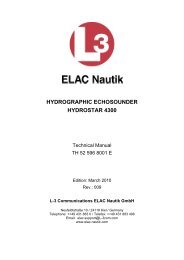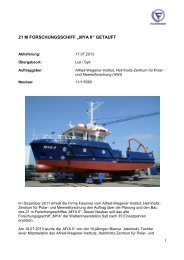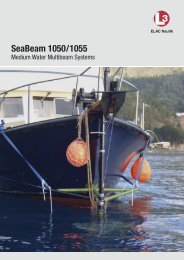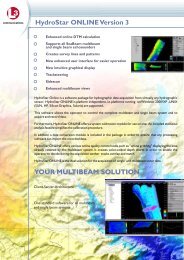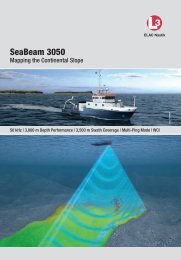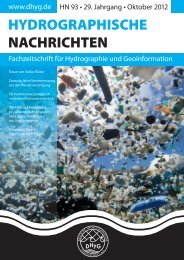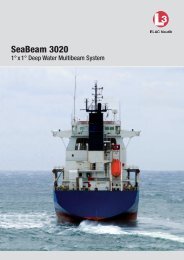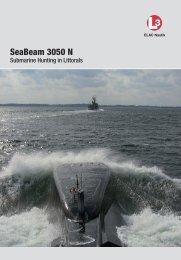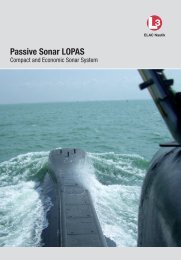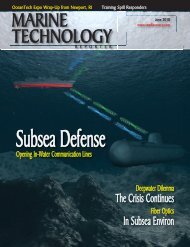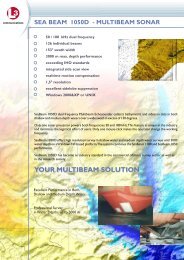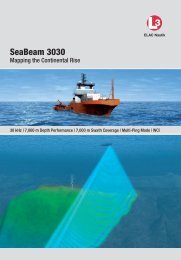SeaBeam 3012 - Elac-Nautik
SeaBeam 3012 - Elac-Nautik
SeaBeam 3012 - Elac-Nautik
You also want an ePaper? Increase the reach of your titles
YUMPU automatically turns print PDFs into web optimized ePapers that Google loves.
<strong>SeaBeam</strong> <strong>3012</strong><br />
Full Ocean Depth Multibeam System<br />
12 kHz | 11,000 m Full Ocean Depth Performance | 31,000 m Swath Coverage | Swept Beam TM
DISCOVER THE UNKNOWN<br />
<strong>SeaBeam</strong> <strong>3012</strong><br />
Full Ocean Depth Multibeam System<br />
<strong>SeaBeam</strong> <strong>3012</strong> is the latest generation bathymetric multibeam system from L-3 ELAC <strong>Nautik</strong>.<br />
This advanced system features the patented, revolutionary transmission technique called Swept<br />
Beam, which compensates fully for vessel pitch, roll and yaw motion.<br />
Performance<br />
<strong>SeaBeam</strong> <strong>3012</strong> is a high performance deep sea echo<br />
sounder, providing excellent bathymetric, bottom<br />
backscatter and side scan data due to its innovative<br />
sonar processing. The system operates at 12 kHz in<br />
water depths ranging from 50 m to 11,000 m, at survey<br />
speeds of up to 12 knots. <strong>SeaBeam</strong> <strong>3012</strong> produces<br />
bathymetric data that exceed the requirements of the<br />
International Standards Organization (IHO) for depths<br />
greater than 100 meters.<br />
Swept Beam Transmission Technique<br />
The main difference between the Swept Beam and a<br />
classical sector scan (separately steered beams) is that<br />
the resulting swath footprints of the swept beams for a<br />
series of pings are evenly parallel spaced lines.<br />
(a)<br />
(b)<br />
Vessel track without stabilization (a), with sector scan (b) and using Swept Beam (c)<br />
High Density Mode<br />
<strong>SeaBeam</strong> <strong>3012</strong> has 301 beams (maximum at equiangular mode). The swath can<br />
be decreased. The number of beams will be constant even if the swath width will<br />
be decreased until a specifi c angle is reached.<br />
(c)<br />
Instead the sector scan produces a couple of hyperbolic<br />
curves with overlapping areas in the across-ship direction.<br />
These hyperbolic curves and overlapping areas<br />
produce some discontinuities which may generate artifacts<br />
in the post-processing.<br />
Key Features<br />
Up to 11,000 m Full Ocean Depth Performance<br />
Up to 31,000 m Swath Coverage<br />
Patented Swept Beam Technology<br />
Multi-Ping Mode<br />
Modular Design for Different Beam Widths<br />
Hull mounted hydrophone frame (fl ush installation)<br />
2
<strong>SeaBeam</strong> <strong>3012</strong><br />
System Overview<br />
Modular Design for Customized Beam Width Solutions<br />
Transmitter and Receiver Control Units<br />
The transmitter control unit supplies the drive signals to the entire projector array.<br />
Each output is separately controlled for power level, phase and frequency. This<br />
faciliates programmable shading and steering, as well as transmit beam stabilization<br />
using Swept Beam.<br />
The receiver control unit controls the overall ping cycle. It contains the receiver<br />
circuits for the hydrophones as well as the signal processor for beam forming,<br />
bottom detection and data reduction. The control units are interfaced to the operator<br />
station via Ethernet.<br />
Transducer Array<br />
The transducer array incorporates a projector and<br />
a hydrophone array in a mills cross confi guration. The<br />
12 kHz projector array has an along track beam width of<br />
1° or 2°. It consists of up to 25 identical modules. The<br />
projectors use Tonpilz resonators.<br />
The hydrophone array has an athwart ship beam width<br />
of 1° or 2° normal to the array. It consists of up to 15<br />
identical modules. The hydrophones use ceramic elements<br />
which have broadband performance to provide<br />
excellent phase uniformity across the array and multifrequency<br />
capability.<br />
Operator Station<br />
The operator station, a PC of latest technology, provides<br />
a graphical user interface on high resolution TFT monitors<br />
for controlling the system using L-3 ELAC <strong>Nautik</strong>'s<br />
HydroStar ONLINE software. It communicates with the<br />
sonar electronics via Ethernet both for control and reception<br />
of sonar data and performs the sound velocity<br />
correction, heave compensation, navigation merging<br />
and data record construction. A variety of real-time data<br />
displays are available for quality control.<br />
Water Column Imaging Workstation<br />
<strong>SeaBeam</strong> <strong>3012</strong> is WCI ready, no extra installation is needed.<br />
The Water Column Imaging (WCI) functionality is<br />
utilized via an additional PC workstation that logs WCI<br />
data and displays real-time images of backscatter from<br />
the water column and sea fl oor, both below and to the<br />
sides of the vessel. The WCI workstation connects to the<br />
<strong>SeaBeam</strong> <strong>3012</strong> multibeam system via Ethernet, and receives<br />
data for each ping from the multibeam.<br />
<strong>SeaBeam</strong> <strong>3012</strong> multibeam system<br />
3
SB 3050 l SB 3030 l SB 3020 l SB <strong>3012</strong><br />
Specifications and Technical Data<br />
Seabeam <strong>3012</strong> at a Glance<br />
Technical Data<br />
Operating frequency<br />
min. depth<br />
max. depth<br />
Along-ship beam width<br />
(-3 dB points)<br />
Across-ship beam width<br />
(-3 dB points)<br />
Pulse length<br />
Pulse length modes<br />
12 kHz band<br />
50 m below transducers<br />
11,000 m (full ocean depth)<br />
1°or 2°<br />
(other beam widths available)<br />
1° or 2°<br />
(other beam widths available)<br />
3 ms - 20ms<br />
max. swath coverage sector > 140°<br />
max. swath coverage<br />
Swath coverage modes<br />
max. number of soundings<br />
Beam spacing<br />
Depth accuracy (sonar sensor)<br />
Physical Specifications<br />
Hydrophone array *<br />
Manual and automatic<br />
approx. 31,000 m (depending on<br />
own noise of the ship and sea state)<br />
Manual and automatic<br />
918 (multi-ping)<br />
Equidistance or equiangular<br />
In accordance with IHO for depths<br />
greater than 100 meters<br />
Interfaces<br />
Power<br />
Height (mm) Width (mm) Depth (mm) Weight (kg)<br />
1° 222 892 7,756 2,136<br />
2° 222 952 4,316 1,200<br />
Projector array *<br />
1° 276 7,740 1,056 3,880<br />
2° 276 4,200 1,116 2,000<br />
Hydrophone junction box 410 600 192 21<br />
Projector junction box 395 640 130 20<br />
Receiver control unit 1,751 600 1,003 337<br />
Transmitter control unit 2,152 606 841 350<br />
Operator station 177 (4 HE) 483 (19” Rack) 505 14<br />
*Dimensions may change due to special installation requirements. Please ask for dimensional drawings.<br />
Stabilization<br />
Roll ± 10°<br />
Pitch ± 7°<br />
Yaw ± 5°<br />
115 V / 60 Hz or 230 V / 50 Hz<br />
single phase<br />
Motion RS232 / RS 422<br />
Heading RS232 / RS 422<br />
Position RS232 / RS 422<br />
Surface sound velocity RS232 / RS 422<br />
Sound velocity profile RS232 / RS 422<br />
L-3 Communications ELAC <strong>Nautik</strong> GmbH | Neufeldtstrasse 10 | 24118 Kiel | Germany | Tel. +49 (0)431-883 0 | Fax +49 (0)431-883 496<br />
elac.marketing@L-3com.com | www.elac-nautik.de | Design changes and errors reserved. Rev. B 18/03/2013<br />
4



